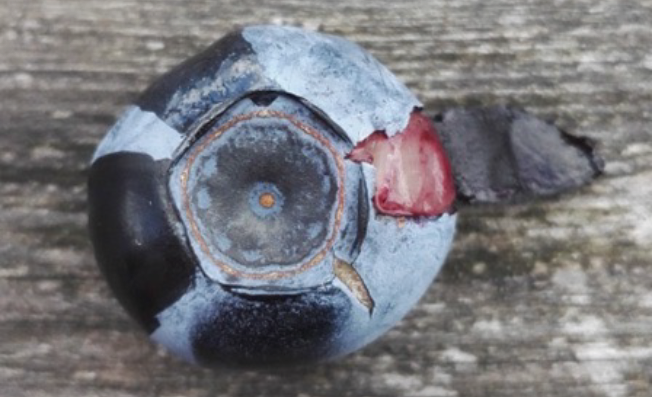What makes blueberries blue?
DOI: 10.1063/pt.utpl.ztul
Blueberries are blue despite the dark red pigments in their skin. The same is true of other blue fruits like some plums, grapes, and juniper berries. Their color was strongly suspected to be a result of the structure of their waxy outer layer, which may play a role in holding in moisture and protecting the fruit. A research team led by Heather Whitney and Rox Middleton at the University of Bristol in the UK has investigated those waxy blue fruits to find out how they produce the color we see.

Ripening blueberries. (Photo by ChiemSeherin/Pixabay.)

To begin, the researchers removed the wax of a blueberry to find how deep the blue goes. Removal of the outermost wax layer removed the brilliant blue color, leaving a very dark blue. But rubbing off the entire waxy covering showed that the underlying outermost skin cells are dark red. In fact, using microscopy, the only pigment found in the berry was observed to be red. That indicated that the blue color occurs in the outermost layer of the waxy covering.
The researchers used a scanning electron microscope to examine the morphology of the outermost layer of different blue fruits. Studying 14 fruit species, they found wax structures that they classified into four types of shape. The first type exhibits rings, the second rods, the third slabs, and the fourth tubes. The exception is the blueberry wax, which was classified differently than all the other species measured. Despite the different shapes of the crystals, they all produced a similar optical-reflectance spectrum. While other examples of both structural and pigmentary color show a clear reflectance peak corresponding with the dominant visual color, the bloom fruits studied by Middleton and colleagues have no peak in the spectrum, which continuously decreases with increasing wavelength. The fruit surfaces reflect the least light around 700 nm, the wavelength reflected by the underlying red pigment in the skin. Instead, the light is scattered from the random structure of the nanocrystals. Because shorter wavelengths are scattered more, to our eyes the dominant color is blue.

When the outer layer of wax coating is removed, a blueberry appears dark blue. When the entire coating is peeled off, the redder skin of the fruit is apparent. (Adapted from R. Middleton et al., Sci. Adv. 10, eadk4219, 2024

To further confirm that the structure is the primary reason we see those fruits as blue, the researchers dissolved the fruit’s wax using chloroform. When suspended in the solution, the wax was transparent in the visible wavelength range. After evaporating the chloroform around the dried wax, the wax crystals self-assembled into a structure similar to that of their natural state. The wax looked blue.
Color appearance without the corresponding pigment isn’t unknown to science. Rainbows stretching across the sky or seen shimmering on a CD create colors by reflecting light as it interacts with structures. (For more on color due to structure, see the article by Ross McPhedran and Andrew Parker, Physics Today, June 2015, page 32.
A version of this story was originally published online on 28 February 2024.
